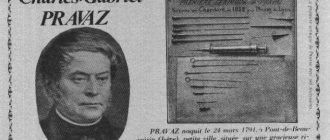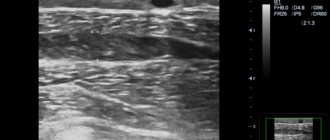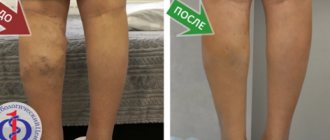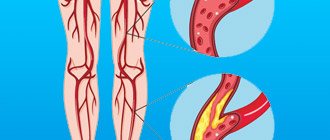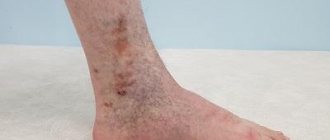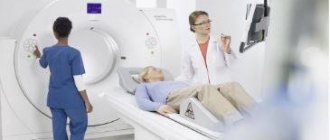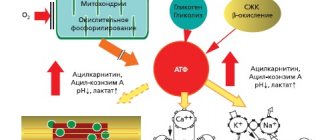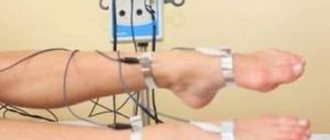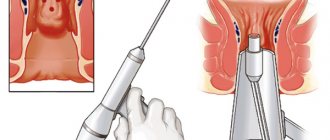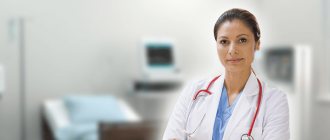Endovasal laser coagulation (EVLC) of veins in Moscow
Endovasal laser coagulation (EVLC) of veins is a modern method of getting rid of truncal enlargement of veins using the thermal effect of laser energy. In this case, the vein is preserved, just as in a standard, usual operation; it is burned out from the inside. This contributes to thrombotic occlusion of the vein, its compression and gradual resorption. The technique is carried out under the control of a special scanning - color duplex, which allows you not to cut the skin, but to carry out the procedure through tiny punctures.
EVLT - endovasal laser coagulation in our center
conclusions
Laser techniques are highly effective in the fight against unwanted blood vessels. Lasers differ in wavelengths, characteristics and effects on different calibers of vessels located at different depths. Among laser devices, the French device Exotherme stands out.
Using vascular coagulation with the Exotherme diode laser with its unique characteristics, we obtain a quick aesthetic result. Using this device, you can influence vessels of different calibers and located at different depths. In this case, coagulation of blood vessels occurs instantly, relieving the patient of complexes. And we, of course, are not saving his life, but perhaps we are changing his fate. When performing laser coagulation of blood vessels with the Exotherme laser, no matter how paradoxical it may sound, our clients receive a relaxing effect: the client is not in pain, comfortable, he sees what is happening to him, and observes the effect on the screen online.
History of the method “Endovasal laser coagulation EVLT” (Wikipedia)
The first exciting reports about the possibility of using lasers in the treatment of phlebology patients appeared in 1981. Dr. Anderson RR and colleagues used a dye laser with a wavelength of about 577 nm, the principle was to damage the microvessels of the skin. The development of the foundations of the technology was based on the process of tissue absorption of laser energy having a certain wavelength, which resulted in their selective destruction.
Only in the 90s of the last century, when new semiconductor structures were released, did it become possible to produce compact lasers. These devices had a long service life at a fairly low cost. In 1998-1999, the first information began to appear about the beginning of clinical manipulations based on the intravascular use of a diode laser for endovasal laser coagulation. As a result, only in 2002 this method was patented by V. Meloni and his colleagues.
Since the advent of the method - endovasal laser coagulation of varicose veins, a video of which was filmed for a more in-depth study of the process, there has been a tendency to increase the energy power supplied to the vessel. The earliest work was carried out at a power of no more than 15 W, and after research work carried out by a number of scientists, reports of high power levels not exceeding 40 W appeared.
The endovasal laser procedure is performed by surgeons and phlebologists Semenov A.Yu. and Kalachev I.I.
Endovasal laser coagulation EVLT in Moscow is of great interest to both surgeons and their patients. The number of publications and studies on this topic increases every year. Endovasal laser coagulation of varicose veins, the price of which may vary depending on the equipment, is becoming more popular every year, thanks to patient education, and is in increasing demand.
Despite all the existing experience, the technology of endovasal laser coagulation is currently still very far from perfect. Therefore, research continues in two directions: standardization of technology and clarification of indications, determining the optimal wavelength of the laser beam.
The most effective laser system for removing blood vessels – Exotherme
The Exotherme system (LSO Medical, France) is a diode laser with a wavelength of emitted light of 980 nm, which is considered the optimal wavelength for effective and safe coagulation of blood vessels at different depths. Moreover, the absorption coefficient of radiation of this type of laser in the blood is much higher than in the surrounding tissues.
The 980 nm wavelength is highly selective with hemoglobin as the main chromophore: it is strongly absorbed by the blood. The operating principle of Exotherme is based on selective photocoagulation, which specifically targets hemoglobin and is characterized by a pulse duration shorter than the vessel's thermal relaxation time (TRT). This principle prevents blood vessels from rupturing as the temperature rise corresponds to the TRT.
When laser radiation energy is converted into heat, this heat accumulates in hemoglobin and then transfers it to the walls of blood vessels. As a result, an increase in temperature (up to 75 ° C) leads to destruction of the vessel wall. Blood coagulates under the influence of temperature. These two effects make sclerosis of the vessel possible.
A special feature of this laser system is multipulse technology.
All laser effects of the Exotherme device are based on three pulses:
- The first pulse (60% power) results in an increase in the optical absorption of the laser target, hemoglobin.
- The second (20% power) is characterized by a lower energy level, but maintains a temperature of 60 to 75 ° C in the vessel.
- A third pulse (20% power), similar to the second, maintains the same level of heating for a period of time equivalent to vessel thermal relaxation (TRT) (600 ms, for a 1.5 mm vessel).
In Fig.1
shown in “time-temperature” coordinates is the increase in temperature in the vessel wall and in the adjacent tissue under sequential exposure to a series of three pulses.
Rice. 1.
Kinetics of temperature increase (vertical axis) in the vascular wall and surrounding tissues in a sequence of three pulses.
Multipulses provide higher efficiency and productivity by increasing the differential absorption of blood into tissues, this allows you to reduce laser energy by 3-4 times, more effectively protect surrounding tissues and prevent side effects. This one of the main points in treatment is more effective and safe. The multi-pulse mode of exposure in combination with the cooling system makes the procedure absolutely painless.
The Exotherme device has a camera built into the handpiece. It provides a tenfold magnification, while the image is transferred in real time to the monitor, giving the opportunity to observe the progress of the procedure not only for the specialist, but also for the patient. Thanks to the x10 optical magnification on the 0.9 mm spot, the laser effect on the vessel is visualized (instant visualization of vessel sclerosis on the screen) for precise treatment and without the risk of overexposure (treated areas are displayed on the screen). The built-in camera and zoom function increase efficiency, save time, and provide a higher level of security.
This device has another advantage - it is contact cooling with sapphire glass (temperature 5 ° C) using the Peltier system. This minimizes pain and the risk of unwanted complications.
In order to correct unwanted vessels, French doctors suggest, at the first appearance of vascular formations, which appear already at the age of 20–25, to carry out coagulation of blood vessels using the Exotherme . Treatment protocols in this case are as follows:
- 1st session - diagnosis of the condition of vascular damage in the patient, carrying out a procedure for coagulation of vascular damage up to 2 mm in size, carrying out preventive work for the treatment of vascular diseases.
- 2nd session - carried out after 2 months.
- 3rd session - held in a month.
- Re-examination - after a year.
Clinical studies conducted in Germany in several laser clinics and at the Department of Dermatology of the University of Munich in 2001 assessed the effectiveness of the 980 nm diode laser in the treatment of venous telangiectasia in the legs. The course of treatment included 3 procedures with an interval of 4 weeks. It was found that the radiation of this type of laser penetrates to a depth of 3 mm and gives good results in coagulating blood vessels. It is important to note that positive results were achieved even with a single laser treatment of the required area. During exposure, no damage to the epidermis was noted due to the low absorption of laser radiation by melanin. The great advantage of this technology is that there is no need for postoperative care; wearing compression stockings is not required.
Repeated studies were carried out a year later (in 2002) at the same medical centers in order to evaluate the long-term results of treatment of telangiectasia with a 980 nm diode laser and compare with the immediate results. It was noted that after 12 months, 75% of patients had more than 75% of their vessels disappeared, and 25% had 50% of their vessels disappeared; no side effects or complications were recorded. As a result, it was concluded that the technology is highly effective and safe and that the achieved treatment result is durable.
Research in Spain in 2003 at the University of Malaga led to the following conclusions:
- Radiation at a wavelength of 980 nm promotes complete coagulation of small vessels and high patient satisfaction.
- The wavelength of 980 nm is absorbed to a small extent by water and melanin, so there is no damage to the epidermis and dermis.
- Vessels with a diameter of 1 mm are a good target for a laser with a wavelength of 980 nm, while the epidermis absorbs virtually no energy.
The use of an irregular sequence of pulses enhances the effectiveness of laser exposure.
In this mode, the transition of oxyhemoglobin (Hb-O2) and deoxyhemoglobin (Hb) into methemoglobin (Met-Hb) occurs, which makes it possible to transfer more energy while preserving the surrounding tissues, ensuring the rapid disappearance of VESSELS WITH A COMPLETE absence of side effects. The Exotherme laser features contact cooling using sapphire glass (Fig. 2)
. A liquid-cooled sapphire tip with a temperature of 5 °C is pressed against the patient's skin for 250 ms before the pulse is applied. At the same time, the temperature of the sapphire glass is higher than the freezing point - there is no risk of skin damage as a result of hypothermia, the laser energy flow penetrates the skin.
Rice. 2.
Schematic illustration of the contact between the sapphire tip and the skin.
It is important to note that cooling with sapphire crystal has a number of advantages. First of all, cooling with sapphire lowers the temperature of the epidermis. Pressing the glass against the skin provides excellent thermal contact and optical coupling of the laser pulse to the skin. Skin compression (squeezing) leads to an increase in energy density in the target at a depth of 1–3 mm and reduces the thermal load on the epidermis by 3–7%. In addition, calculations show that the protection efficiency of a sapphire-cooled system with a 30 ms pulse duration is twice as high as the efficiency of cryogenic cooling with a 3 ms pulse duration for the same target heating (clinical studies were conducted by Kurt Klawun in California). It is also important that the cooling that continues after the pulse increases the rate at which the skin returns to its normal temperature, which increases the comfort of the procedure for the patient. It is also important to note that the sapphire window is part of the laser system and does not require consumables or additional operating costs. Thus, contact cooling with sapphire glass provides complete protection of the epidermis, there is no risk of frostbite and burns, and the patient experiences maximum comfort during and after the procedure.
As already mentioned, the Exotherme installation has a built-in camera that allows you to visualize the progress of the procedure (Fig. 3, 4)
. Using a camera, the doctor observes the treatment area on an enlarged and convenient scale, which ensures that the laser beam accurately hits the vessel. In addition, the doctor controls the progress of the procedure - the strength of the impulse and the sclerosis of the vessel. It is psychologically important that the patient has the opportunity to follow the progress of the procedure in real time on the monitor, and this allows both the patient and the doctor to give an immediate assessment of the procedure being performed. Yandex
Rice. 3-4.
Visualization of the procedure using the Exotherme diode laser. The left picture shows the built-in camera pressed to the surface of the skin, the right picture shows the image of the vessel on the monitor.
To effectively remove blood vessels, 1 to 3 procedures are required.
The patient must be told about the prevention of varicose veins:
- It is not recommended to get carried away with hot baths, saunas, or prolonged exposure to the sun (all these factors contribute to a decrease in venous tone and lead to stagnation of blood in the legs).
- You should not wear tight underwear (stockings and socks with tight elastic bands!).
- Sports activities include swimming, walking, cycling and skiing, but bodybuilding, weightlifting and tennis should be avoided.
- Shoes must have heels no more than 4 cm.
- If you feel heavy legs in the evening, it is recommended to place a cushion under your shins.
- The diet should be rich in vegetables and fruits (both raw and cooked), healthy nuts, compotes, tea, coffee, eating foods with the addition of vinegar, lemon and vegetable oil, vegetarian, Mediterranean and DASH diets are recommended. Foods to avoid: sausages, eggs, bread, pastries, potatoes, chocolate and alcohol.
- Supplementation with antioxidant supplements, magnesium and potassium, and omega-3 polyunsaturated fatty acids is recommended.
- You should stop smoking.
- It is necessary to drink up to 2 liters of water per day.
Carrying out laser coagulation of blood vessels with the Exotherme laser, we carry out preventive work, talking about the factors causing vascular pathologies, their prevention and treatment. We can adjust the patient’s eating habits, lifestyle and give recommendations to a specialized specialist.
Typical examples of vascular patterns on the skin of the legs before and immediately after the laser coagulation procedure are shown in Fig. 5
.
Rice. 5.
Typical examples of vascular patterns on the skin of the legs before and immediately after the laser coagulation procedure.
Endovasal laser coagulation (EVLC) on the veins of the lower extremities - what is it?
The principle of performing the endovasal laser coagulation procedure is based on the thermal effect of laser radiation on the inner part of the surface of the vein. But, as we found out through a huge number of different types of research, the laser does not fully affect the surface of the vessel walls. Most of the energy is absorbed by the blood contained in the vessel. In the blood, already under the influence of a light pulse, steam bubbles are formed, which come into contact with the wall of the vein, resulting in a thermal effect. Next, coagulation of proteins occurs in deeper layers due to damage to the endothelium.
It is the destruction of the endothelium that is of primary importance as a result of treatment. Some viable endothelial cells are preserved, which in the future will be an important source of wall regeneration. The destruction process must be complete, and this is only possible as a result of creating an optimal laser radiation energy density in the lumen of the vessel, which results in its “charring.” However, you should carefully select the laser power, otherwise, with a stronger impact of the device, the vessel wall may be perforated.
What happens to the vein during laser radiation during EVLT
The latest models of lasers for endovasal laser coagulation have a wavelength of 1940 nm, at which the laser radiation is absorbed to a greater extent by the water of the venous wall and the blood itself. Direct exposure to the vein wall reduces the radiation strength, the appearance of charring and heating of the working surface. This contributes to a lower likelihood of perforation of the vessel wall and the appearance of pain in the postoperative period. This wavelength is ideal for larger venous trunks that have a diameter of more than 10 mm.
Lasers for removing blood vessels and their types
Potassium titanium phosphate (KTP) laser, 532 nm
So-called vascular lasers emit a wavelength of 532 nm, which corresponds to the yellow-green spectrum of the visible range. The second peak of hemoglobin absorption is located in this range. Therefore, the main point of application of this laser gave it its name - vascular laser. Although this is not the only application of this wavelength.
Due to the relatively short wavelength, the light of this laser does not penetrate deep into the skin, which sharply reduces the effectiveness of treating deep-lying formations. However, the extremely strong absorption of 532 nm light by hemoglobin makes it possible to successfully treat vascular formations located on the surface.
The main complication is postoperative erythema on all treated areas. Almost no scarring or ulceration was observed. Histological analysis shows that the closure of the vessels occurs without bleeding.
KTP lasers are usually pumped by a direct current arc lamp. The pulse length is in the range of 1–100 ms, and the power of a single pulse can reach 200 W (energy density at the skin surface can exceed 100 J/cm2), which may be unacceptable when treating port-wine stains in children or superficial pink lesions.
Vascular laser is more often used for photocoagulation of dilated vessels on the face, for the treatment of rosacea, and the removal of superficial port-wine stains.
Copper vapor laser, 510, 578 nm
It works on the principle of heating copper metal to melting and evaporation temperatures. The laser generates radiation with two wavelengths: 511 nm (green) and 578 nm (yellow) with a power ratio of 3:2. As a result, the radiation effect of this laser occupies an intermediate position between KTP and PDL lasers, i.e., it is intensively absorbed by hemoglobin with a shallow penetration depth.
The pulse duration is about 20 ns (hundreds of times less than the thermal relaxation time of even small vessels), resulting in minor nonspecific thermal and significant mechanical damage. A high pulse repetition rate is necessary when treating large vessels: since a single pulse is not enough, their coagulation requires a series of pulses, in the interval between which the vessel should not have time to “cool down”. All this makes it possible for a copper vapor laser to safely coagulate large telangiectasias.
Pulse Dye Laser (PDL), 575–600 nm
Dye lasers have the great advantage of being able to produce custom wavelengths depending on the dye used. There are lasers in this series for tattoo removal. To remove blood vessels, a wavelength of 585–595 nm is used. This corresponds to the yellow spectrum of the visible range.
The chromophore will be both oxy- and deoxyhemoglobin, but the disadvantage is a very sharp time profile and short pulse duration, which increases the likelihood of long-term hyperemia. The relatively small depth of penetration does not allow treating deep-seated vessels (especially when they are densely clustered): at a power of 8 J/cm2, vessels are coagulated at a maximum depth of 0.7 mm, even in cases where they are not blocked by overlying vessels.
The range of possible wavelengths allows the use of longer ones when treating deeper vessels.
Alexandrite laser
Alexandrite lasers emit light at a wavelength of 755 nm and are traditionally used for laser hair removal. As a rule, for hair removal, an alexandrite laser generates pulses of 3–5 ms. However, systems with longer pulses of 10–200 ms can also remove vessels. Unlike vascular lasers, IPL and dye lasers, alexandrite lasers have greater depth of penetration of the laser beam and a lower risk of burns.
Diode lasers
At the moment they are perhaps the most effective, safe and painless. Diode lasers have high efficiency, durability and low maintenance. The most commonly used diode lasers in dermatology are wavelengths of 805–810, 930, 980 and 1060 nm, which are similar to the neodymium laser. The advent of long-pulse lasers with the ability to adjust pulses from 10 to 200 ms allows the use of diode lasers for the removal of blood vessels. The second positive point is the greater depth of penetration compared to the methods described above. The wavelengths of diode lasers make it possible to effectively remove deep-lying targets, such as veins in the legs.
Nd:YAG laser, 1064 nm
Long-wave radiation penetrates quite deeply into the skin, but the selectivity of its absorption is low. This is due to the fact that absorption by hemoglobin and melanin is similar in intensity. The absorption by water is not so great, but it is already becoming noticeable. Thanks to these factors, coagulation of superficial and deep-lying vessels with a diameter of even more than 1 mm is possible. The relatively weak absorption by hemoglobin requires the use of high radiation energy densities, so there is a need for epidermal skin cooling and sometimes local anesthesia. However, after exposure it is sometimes impossible to avoid atrophic scarring.
Indications for the EVLT procedure:
- The estuarine expansion of the vein can be of absolutely any diameter. Since modern laser generators and radial light guides are capable of closing veins regardless of their diameter. All methods for carrying out such manipulations are standardized and have excellent results.
- A fairly straight main vein. If there are bends, it can be difficult to pass through the endovasal guide; in such cases, several light guides are placed.
A complex case - EVLT after thrombophlebitis: several light guides were installed
Contraindications to the EVLT procedure:
- Established thrombophilia, since the method of endovasal laser coagulation implies the formation of a blood clot near the lumen of the femoral or popliteal vein and further blood clotting, which is a threat to the thrombotic process in the veins and thromboembolism of the arteries of the lungs.
- Chronic ischemia of the lower extremities, since an important stage of laser coagulation is the mandatory use of compression bandages for some time after surgery, which can aggravate ischemia.
- Inability to activate the patient after surgery. It is known that the best way to prevent postoperative complications is to mobilize the patient. The endovasal laser coagulation method requires the patient to get up from the operating table independently and move for a certain time.
- The presence of inflammation in the intervention area, which can serve as a source of infection.
Endovasal laser coagulation of varicose veins - procedure technique
The operation - endovasal laser coagulation (EVLC), the video of which you can watch on this page of our website, occurs as follows: markings are carried out on the patient’s skin using ultrasound control.
Kalachev I.I. carries out markings before EVLT surgery
Then the lower limit of reflux is determined directly, which is located at the junction of a large inflow. The second mark is placed 3-4 cm distal from the first, where the puncture will be performed. Next, the points of confluence of the tributaries are marked and varicose dilated tributaries are marked, regardless of the method of removal.
Venous puncture is performed only under ultrasound guidance
The technique of endovasal laser coagulation includes five steps:
- Puncture of the saphenous vein and direct insertion of the light guide.
- Determination of the working section of the light guide.
- Beginning of anesthesia.
- Application of laser.
- Application of a bandage.
Price for services
| LASER TREATMENT OF VASCULAR PATHOLOGY LASER THERAPY OF VASCULAR PATHOLOGIES, MULTILINE LASER COMPLEX, YAG SYNOSURE ELITE MPX | |||
| № | Name | Duration | price, rub. |
| 1 | Single vessel | 10 min | 500 |
| 2 | Wings of the nose | 20 minutes | 1500 |
| 3 | Cheeks | 30 min | 2000 |
| 4 | Chin | 20 minutes | 1500 |
| 5 | Leg vessels 1st degree | 30 min | 3000 |
| 6 | Leg vessels 2nd degree | 40 min | 4000 |
| 7 | Leg vessels 3rd degree | 60 min | 6000 |
| 8 | Treatment of rosacea | 30 min | 2000 |
| PHOTOTHERAPY FOR VASCULAR PATHOLOGY WITH BROADBAND PULSE LIGHT, IPL, CYNOSURE ELITE MPX LASER | |||
| 9 | Single vessel | 10 min | 500 |
| 10 | Wings of the nose | 20 minutes | 1500 |
| 11 | Cheeks | 30 min | 2000 |
| 12 | Chin | 20 minutes | 1500 |
| 13 | Leg vessels 1st degree | 30 min | 3000 |
| 14 | Leg vessels 2nd degree | 40 min | 4000 |
| 15 | Leg vessels 3rd degree | 60 min | 6000 |
| 16 | Treatment of rosacea | 30 min | 2000 |
| LASER CORRECTION OF PIGMENTATION, LASER COAGULATION OF PIGMENT SPOTS, CYNOSURE ELITE LASER | |||
| 17 | 1 sq. cm | 5 minutes | 500 |
| 18 | up to 5 sq. cm | 10 min | 1000 |
| 19 | up to 10 sq. cm | 15 minutes | 2000 |
| 20 | up to 20 sq. cm | 20 minutes | 3000 |
| 21 | up to 100 sq. cm | 30 min | 4000 |
| 22 | up to 200 sq. cm | 60 min | 6000 |
Endovasal laser coagulation (EVLC) - postoperative period
After the compression stocking is put on, the patient should walk for at least 40 minutes.
After EVLT surgery, compression stockings are worn.
24-hour compression lasts 2 days. Then only during the daytime for about a month. The first scheduled examination with ultrasound angioscanning occurs the next day.
Quite rarely, more often in patients with a low pain threshold, complications are rare in the first 24 hours after the procedure - endovasal laser coagulation (EVLC). There may be slight pain in the limb. Discomfort is more often associated with an incorrectly worn compression stocking, which puts pressure on the limb, rather than with postoperative trauma.
Endovasal laser coagulation (EVLC), photos of the postoperative period of which demonstrate that there may also be bruising along the length of the coagulated vein, is the safest procedure for varicose veins. The cause of bruising may be penetration into small capillaries during tumescent anesthesia. Sometimes there is a feeling of tension in the thigh, a feeling of tension in the vein. This all usually goes away within 1.5 months. A short-term increase in body temperature to subfebrile levels is possible.
In about a fifth of patients, 4-6 days after endovasal laser coagulation, a pulling sensation may appear along the vein - this is normal!
Over the past 3 years, endovasal laser coagulation (EVLC), the cost of which is still quite high, has undergone a number of changes. For example, the most modern laser devices have appeared, such as water lasers.
Modern laser technologies in
Another important change is the formation of deep understanding among phlebologists about the presence of important indications for this technique. Endovasal laser coagulation of varicose veins, the reviews speak for themselves, has recently become widely known and has earned trust among doctors and patients. Over the course of several years, vast experience has been accumulated in the use of endovasal laser coagulation to eliminate venous pathology, and relevant new findings have been published in all world medical publications on phlebology.
Causes of vascular pathology on the face
Dilation of capillaries is a cosmetic defect and does not pose a health hazard. As a rule, sensitive dry skin is prone to manifestations of rosacea and spider veins, but often those with oily skin have similar problems. Most often, the vascular network appears on the wings of the nose and cheeks.
There are several main causes of vascular pathologies of the face:
- Hereditary predisposition. The likelihood of vascular pathologies occurring is high if one of the parents suffered from this disease.
- Bad habits. Smoking and alcohol negatively affect the state of the vascular system, in particular small capillaries are affected. Often on the face of people who abuse alcohol. You can notice the characteristic vascular network.
- Tanning abuse. Excessive exposure to the scorching sun negatively affects the walls of blood vessels, weakening them and causing the formation of rosacea and spider veins.
- Kidney, liver and hypertension diseases. In this case, vascular pathology is a symptom of an internal disease.
- Cosmetology procedures. Violation of technology or procedures incorrectly selected for the skin type, use of aggressive agents - all this can thin and dehydrate the epidermis and provoke vasodilation.
- Temperature changes. Excessively low or high temperatures, as well as regular frostbite or prolonged exposure to elevated temperatures can cause the appearance of dilated capillaries in the facial skin.
Endovasal laser coagulation of veins - price for the laser procedure
The price for the endovasal laser coagulation of veins procedure in our clinic is strictly fixed, and therefore, when contacting us, patients can count on high-quality service, treatment and an affordable cost. And remember that timely consultation with a doctor will completely cure the disease and avoid its recurrence.
| Service | Treatment category | Price |
| Endovasal laser obliteration (coagulation) of veins on one lower limb (Biolitec, Germany) | Category I Initial varicose veins | 35200₽ 44000₽ |
| II category Pronounced varicose veins | 43200₽ 54000₽ | |
| III category Complicated varicose veins (for thrombosis or trophic ulcer, etc.) | 51200₽ 64000₽ | |
| Disposable radial light guide Biolitec (Germany) | One venous pool | 15000₽ |
| Endovasal laser obliteration (coagulation) of varicose nodes and perforators on one lower limb | Category I | 20000₽ 25000₽ |
| II category | 28000₽ 35000₽ | |
| III category | 36000₽ 45000₽ | |
| Total endovasal laser obliteration (coagulation) of veins on one lower limb (Biolitec, Germany) (without miniphlebectomy according to Varadi) | At any stage of varicose veins | 55200₽ 69000₽ |
| Additional laser obliteration (coagulation) of the perforating vein (Biolitec, Germany) | At any stage of varicose veins | 12000₽ 15000₽ |
| Isolated laser obliteration (coagulation) of the perforating vein (Biolitec, Germany) | At any stage of varicose veins | 31200₽ 39000₽ |
| Additional Biolitec radial light guide | When treating several venous pools on one lower limb | 15000₽ |
| Appointment with an expert phlebologist with ultrasound examination based on the results of treatment for one year | for free |
Prices for innovative procedures at the phlebology center have remained stable for many years. The cost of the endovasal laser coagulation procedure on one venous pool at the Moscow Phlebology Center is 44,000 rubles. The price of the service includes:
- Local anesthetic care.
- Cost of a disposable laser light guide.
- Cost of consumables.
- Endovenous laser coagulation procedure.
- Dressings and annual follow-up after the procedure with duplex ultrasound guidance.
For the convenience of our patients, we work with banks that offer credit lines. Also in our center there is a flexible system of discounts and installments. Payment by Visa and Mastercard is possible. At the end of the course of treatment, the patient is given a package of documents to submit to the tax office for tax deduction.
Why do varicose veins occur?
Varicose veins occur when the functioning of the vein valves is impaired. This leads to disruption of venous outflow and dilation of veins. It cannot be said that only women are susceptible to such disorders; men also experience this disease. According to statistics, 67% of women and 50% of men have chronic diseases of the veins of the lower extremities. These disappointing statistics show that, regardless of gender, more than half of the population of our country is susceptible to varicose veins.
So how can you prevent the appearance of varicose veins? Diagnose it and treat it?
First things first. The first and most important thing to know is that there is no prevention for varicose veins. You need to be prepared for the fact that varicose veins may appear regardless of how you live, what your lifestyle is, nutrition and other behavioral factors. There is no prevention, but there are symptoms and factors that can affect the premature appearance and manifestation of varicose veins.
Symptoms:
- Constantly painful and swollen legs (heaviness in the legs and increased fatigue of the legs)
- By the end of the day, shoes become tight and uncomfortable
- The “pattern” of socks on the feet becomes very clearly visible
- A blue-red “web” of vessels on the legs began to appear (spider veins on the legs)
- Night leg cramps
- Itching, redness, dermatitis, eczema on the legs, trophic ulcers
- Tendency to varicose veins (you have already been/are being seen by a phlebologist)
All these symptoms are signals from the body and you urgently need to visit a phlebologist. If for various reasons you do not hear your body, this can lead to varicose veins and manifest themselves more clearly. When varicose veins appear, unfortunately, you will have to forget about skirts and clothes that allow you to show off your legs, which is very unpleasant for most women. The varicose veins themselves, if they do appear, should under no circumstances be neglected and ignored. As soon as the first symptoms appear, you must immediately make an appointment with a doctor. It is important to understand that varicose veins are a disease and it has complications that can cause serious harm to the patient’s health. For example, dermatitis, ulcers and bleeding can not only deprive a person of his ability to work for a long time, but also lead to disability. The formation of blood clots in varicose veins is also a serious complication. As many years of practice have shown, varicose veins cannot be cured with massage, tablets or ointments. A reduction in symptoms is possible, but not a complete recovery! And the external manifestations of varicose veins will not allow you to feel confident when wearing skirts or undressing on the beach. Those. In addition to external inconveniences, the patient also feels psychological discomfort from this disease and limits himself when choosing clothes and lifestyle.
If you have any suspicions about the appearance and development of varicose veins, do not delay, visit a doctor. In our clinic, you can undergo a full examination (diagnostics) - examination of the veins, which will help to accurately identify problems and make a diagnosis, or dispel your doubts. If suspicions are confirmed, our specialists will help you choose an individual course of treatment and get rid of varicose veins.
Advantages of classical endovasal laser coagulation:
- no skin incisions - good cosmetic effect (no stitches, scars)
- minimum rehabilitation period. After the procedure, the patient can immediately begin work.
- rare bruises and hematomas after surgery (minimal tissue trauma).
- complete absence of pain. Carrying out local tumescent anesthesia in any case guarantees the presence of motor processes immediately after the operation, so much so that the patient can leave the clinic completely calmly 60 minutes after the operation.
- minimal wearing of compression stockings after the intervention.
Well-coordinated team work
Today, endovenous laser coagulation, the cost of which can be found by calling the medical center, is the safest type of surgical intervention for varicose veins in our country.
Endovasal laser coagulation of varicose veins - complications
Today, Russia has accumulated vast experience in the use of endovascular laser operations on the veins of the lower extremities. Therefore, the risk of complications is minimized. They are so rare that isolated cases are discussed separately at conferences.
Endovenous laser coagulation, photos of which can be viewed online, is a fairly painless, safe and simple procedure. Therefore, the demand for it is constantly growing. Every day, more and more patients prefer it to classical, outdated techniques.
Single and double pulse technology
ALMA-Q operates in standard and quasi-long-pulse modes, emitting laser energy using “flat beam profile” technology. In this case, the peak energy in a pulse can reach up to 2 J. The flat profile of the beam helps, even at maximum peak power, to evenly distribute energy in the working spot and minimize the risk of damage to the epidermis. Single and dual pulse modes are available for all ALMA-Q Q-switch Nd:YAG laser wavelengths, including 1064 nm, 532 nm, 585 nm and 650 nm.
Endovasal laser coagulation (EVLC) reviews
Patient's review of treatment with endovasal laser coagulation in our center
Smutnaya Tatyana Nikolaevna, Obninsk. 10/04/2019
My grateful review about doctor phlebologist Dmitry Anatolyevich Fedorov.
I first met him in June 2010. At that time I was 57 years old. I developed varicose veins in my legs from the age of 30, and by this age I was already actively seeking the help of a phlebologist. A friend helped me and advised me to go to a Moscow clinic for phlebology problems, on Vasilisa Kozhina Street. The first examination was carried out by Dmitry Anatolyevich, who said that he could offer outpatient surgery and soon performed complex surgical actions requiring precision.
This was followed by attentive support and correction for 6 months, with strict implementation of the recommendations. The treatment was not difficult to tolerate. The difficulties were different: the summer of 2010 was very hot, there was smoke from forest fires in the cities, interruptions in the movement of electric trains, but all this was offset by gratitude to the doctor for my “light” legs.
My disease is chronic. Time passed, I felt the need to see the doctor again and was about to call the Moscow clinic when I found out that on Kolomenskaya, at the MIFC clinic, a phlebologist works and this is Dmitry Anatolyevich Fedorov. What a joy! THIS IS MY DOCTOR!
So in April 2021, I met with Dmitry Anatolyevich for the second time, with his big, skillful hands. This time he performed surgery on both legs using a laser. The operation was very easy. After leaving the operating room, you can continue to go about your normal life. And these are not words of advertising. This is the doctor's knowledge of modern, high-tech treatment methods. I would especially like to note that Dmitry Anatolyevich generously shares his professional knowledge; doctors were present at both of my operations, to whom he passed on his experience.
Dear Dmitry Anatolyevich, I sincerely thank you for the health of my legs and for your high professionalism. Smutnaya Tatyana Nikolaevna, Obninsk. 10/04/2019
Patient's review of the EVLT procedure performed in our
Maria, 41 years old, Moscow region, Krasnogorsk.
Endovenous laser coagulation, reviews of which I had previously studied on the Internet, turned out to be absolutely painless. I spent 3 hours in the hospital, which included the preoperative period, surgery and 30 minutes after. I was satisfied with everything. True, I had to wear special tights for a month, but it’s good that by summer I took them off. There were only 20 small punctures in the lower part of the leg, now they are no longer visible. My leg doesn’t hurt at all, but before the surgery my bad leg was constantly aching. Thanks to the phlebologist, the wonderful doctor Vladimir Vyacheslavovich Raskin for his good attitude and professional work. Maria, 41 years old.
Patient's review of endovenous laser coagulation surgery in our center
Stanislav, 47 years old, Moscow.
My leg constantly hurt, there was a buzzing sensation in it at the end of the day. I didn’t dare to have surgery using the classical method, because it was scary after reading reviews online and possible complications. Before the operation, I was offered endovenous laser coagulation, in Moscow, at the phlebology medical center MIFC, where I decided to have it done, they did an ultrasound, donated blood and that’s it. After the operation, I was forced to get up from the table and walk for about an hour. The next day I saw the doctor, I was warned that compression stockings must be worn for up to 3 weeks. I didn’t worry about the scars, although I’m glad that they are no longer visible. Six months have passed since the endovasal laser coagulation procedure. Everything is great. Thanks to all the staff from doctors to nurses and especially administrator Tatyana for your attention. Stanislav, 47 years old.
New life for your feet
After the operation has taken place, a period of recovery has passed and all traces of EVLT have disappeared (i.e., after a fairly short period of time), the patient’s legs, and this especially applies to female patients, regain the beauty of their legs. Peace of mind comes and anxiety about the appearance of your beautiful legs disappears. You no longer need to limit yourself in choosing your wardrobe. But with all this, you should not forget and ignore the doctor’s recommendations. It is necessary to undergo examination by a phlebologist, according to his prescription. And you need to get into the habit of strengthening blood vessels, not doing it regularly, but constantly. The body needs your help. Reliable modern technologies, the professionalism and experience of our doctors and your active desire to get rid of the disease will not give varicose veins the slightest chance to develop!
Remember the main advantages of EVLT over other methods:
- The operation is performed on an outpatient basis or discharged on the day of surgery, the duration of the operation is 30-40 minutes
- Cosmetic effect. No skin wounds or stitches
- Less traumatic manipulation
- No anesthesia required. The operation is performed under local anesthesia
- Return to work is possible the next day after surgery
Endovasal laser coagulation of veins - treatment results. Photos before and after the EVLT procedure
The result of patient treatment in our phlebology center using endovenous laser coagulation (EVLC) using the German Biolitec technology
Photos before and after endovenous laser coagulation (EVLC) on the right lower limb
The result of patient treatment using endovenous laser coagulation (EVLC) using the German Biolitec technology
Photos before and after endovenous laser coagulation (EVLC) on the left lower limb
Reviews from patients about laser treatment of varicose veins.
Review of a patient from Moscow about the endovenous laser procedure (EVLT).
Vlasova I.A., January 20, 2019, Moscow
I, Irina Anatolyevna Vlasova, born in 1966, in January 2021, performed laser treatment for varicose veins at the Moscow Phlebology Center with doctors A.A. Antipov. and Semenova A.Yu. During the laser manipulation, apart from pleasure, I did not experience any other sensations. The doctors and nursing staff joked all the time, but the main thing is the result that I have been observing on my legs for six months. My only regret is that I didn’t seek help earlier. I express my deep gratitude to the doctors and wish them further development in their specialization and always excellent results. Vlasova I.A., Moscow.
Review of a patient from Moscow about endovasal laser coagulation (EVLC).
Vologina Alexandra, November 8, 2018, Moscow
I would like to express my great (enormous) gratitude to the wonderful doctors - Alexey Aleksandrovich Antipov and Artem Yurievich Semenov for an excellent operation (EVLT), for their attentive attitude towards patients, for their sense of humor! At each subsequent appointment I go to Alexey Alexandrovich with pleasure, and not because I need to. In general, I was very afraid of the operation, I was scared to go, but everything went very well, thanks to the professional and coordinated work of these specialists.
And now my life is divided into “before” the operation and “after”. I finally felt like a full-fledged woman, not ashamed of myself, my legs!!! I am happy to demonstrate this. Thank you very much!!! Your grateful patient, Alexandra Vologina from Moscow.
Frequently asked questions from patients on the Internet about endovasal laser coagulation (EVLC)
Endovasal laser coagulation of the veins of the lower extremities, what is the cost in Moscow?
The pricing for the endovasal laser coagulation procedure in Moscow can vary significantly. It must be taken into account that the cost of innovative treatment cannot be below certain figures. In our Moscow city phlebological center, innovative treatment is carried out according to modern European standards, the price of endovasal laser coagulation on one venous pool is 59,500 rubles.
Endovasal laser coagulation of varicose veins, how to find out patient reviews?
There are more resources on the Internet that publish patient reviews about this or that technique. Unfortunately, you can’t believe everything that is written there. To ensure the reliability of patient reviews on the website of our phlebology center, almost every review is supported by photographs. You can read reviews from our clinic patients about the endovasal laser coagulation procedure on our website page: .
Where can I watch a video of endovasal laser coagulation of the veins of the lower extremities?
You can find a video of endovasal laser coagulation of the veins of the lower extremities, as well as video materials about the activities of the City Phlebology Center on the page of our website: .
Endovasal laser coagulation of varicose veins, cost of treatment in Moscow?
The cost of treatment using the innovative procedure of endovasal laser coagulation at the Moscow City Phlebology Center is 59,500 rubles. Our phlebology center uses modern equipment of the latest generation, procedures are performed by experienced specialists, experts in the field of endovascular interventions.
Does the type of light guide matter: radial or end?
At Moscow we use the currently best laser with a wavelength of 1470 and exclusively fibers with a radial emission type.
Before the advent of laser light guides with a radial emission type in 2008, EVLC technology was inferior in efficiency to radiofrequency obliteration. There were also restrictions for working on the diameter of the vein. For veins larger than 1 cm in diameter, a different treatment was recommended.
Radial light guide – covers any diameter of varicose veins
The fundamental difference between a radial fiber and an end fiber is the presence of a microlens that scatters laser radiation. This design made it possible to give the energy emanating from the light guide a ring shape, which in turn made the laser’s effect more directed. This made it possible to achieve the effect of vein coagulation using less energy.
We can name the main advantages of radial fibers over end fibers:
- There is no restriction on the diameter of the vein.
- Reducing the total amount of energy made it possible to achieve absolute painlessness of both the procedure itself and the postoperative period.
- Almost complete absence of hematomas and inflammation in the intervention area after the procedure.
- Fast and comfortable recovery.
Unfortunately, not all, even leading clinics in our country, use light guides with a radial emission type. The reason is simple, end fibers are much cheaper. In these clinics you will be denied laser treatment if the vein diameter is more than 1 cm. Most likely they will tell you that your case is very advanced and difficult for laser and will offer a regular operation with an incision. It's not a good practice, but it does happen. Those few public hospitals where equipment for laser operations has appeared work exclusively with end-type optical fibers. This probably explains the use of anesthesia and spinal anesthesia during interventions, as well as not always good treatment results.
